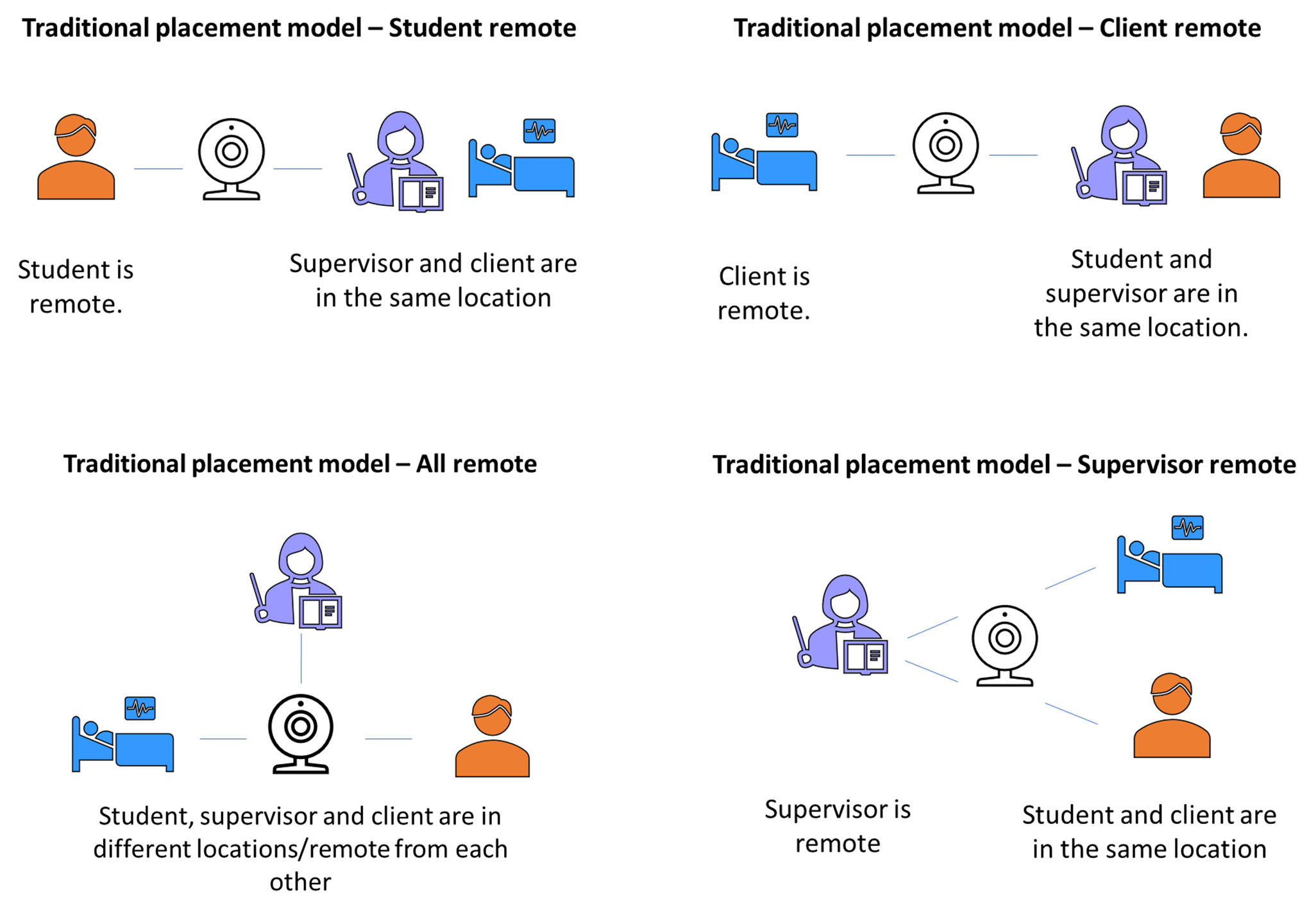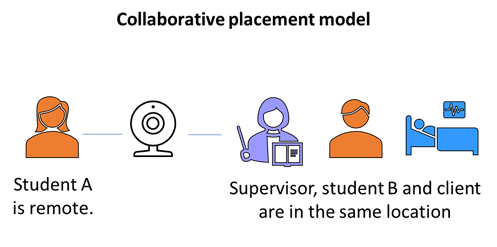Virtual health care is defined by the New South Wales Government Agency for Clinical Innovation as:
‘any interaction between patients and/or members of their care team occurring remotely, using technology with the aim of facilitating or maximising the quality and effectiveness of patient care’.
Some examples of virtual health care include telehealth, online prescriptions (eScripts), online consultations, remote monitoring, and electronic health records. Virtual health care is now part of mainstream health care in Australia. It is therefore important to provide students with the opportunity to develop the knowledge and skills to deliver evidence-based high-quality virtual care.
Many aspects of virtual supervision are no different from a face-to-face placement. Virtual supervision in traditional placement models can look quite different, depending on where the supervisor, student and client are located. Some of these models are illustrated below:

Virtual placements can include other placement models, including project-based and role emerging placements, as well as collaborative placement models, as illustrated below:

For more on placement models, visit: Placement models and approaches to supervision
-
Advantages and challenges associated with virtual supervision models
Advantages and challenges of providing virtual supervision are outlined in the table below:
Table: Advantages and challenges associated with virtual supervision models
Advantages Challenges - Uses technology to enhance service delivery
- Cost and time effective (reduced travel to remote sites, allowing more time for supervision)
- Opportunity for students to be responsive and flexible
- Potential for less informal learning
- Communication requires deliberate and careful planning
- Less opportunity for observing team dynamics, interactions and learning in this way, as supervision is ‘scheduled’
- Challenges the traditional view of ‘placement’. Students may feel disappointed or overwhelmed as their perception of placement may be different to their experience of placement
- Difficulty in assessing students’ performance using practical examinations
-
Considerations for supervisors planning virtual placements
In addition to standard preparation and planning for placement activities, supervisors should consider the additional guidance and support that may be required for students who are embarking on virtual placements and/or with virtual supervision. You may find the following checklist useful when planning a virtual placement:
Checklist for virtual supervision:
Communication I have discussed with the student how learning opportunities will be supported and supervised in the virtual placement model. ☐ I have discussed with the student how assessment will be supported and implemented in the virtual placement model. ☐ I have discussed online communication expectations with the student and provided them with resources to support them learn how to communicate in an online environment. ☐ I have scheduled opportunities before and during the placement, for me to get to know the student and to develop a working relationship in the online environment. ☐ I have ensured that there are both formal and informal sessions scheduled with the student to promote connection. ☐ Placement type and progression I have selected a placement model that fits the health service and virtual placement environment, and university requirements. ☐ I have planned the placement to provide the student with the opportunity to progressively immerse themselves in client care, in a structured and developmental manner.
For example, starting with setting up online consultations, shadowing virtual health clinics (patient consent required), consulting simple cases (or providing part of the consult) and progressing to a full caseload.
☐ Informal learning opportunities I have explored the functionality of the virtual platform to support students while they are working with clients (for example use of messaging/chat function or communicating off screen during supervision sessions). ☐ I have scheduled online contact time (i.e., without clients) to ensure professional socialisation for the student with other team members. ☐ I have planned local team‐based activities and events so that the students and supervisors can meet in person (facilitated within local restrictions). ☐ Assessment I have contacted the university to establish how assessment should be completed in a virtual environment. ☐ I have reviewed the assessment criteria/competencies and have considered how they can be demonstrated in a virtual environment. ☐ I can join a student-client session as a third party (if the supervisor and student are not co-located). ☐ Documentation I have established how client documentation will occur in the virtual healthcare environment and it meets my organisation’s requirements. ☐ I have established a process for countersigning health record entries completed by the student (if required). ☐ Student safety I have reviewed and I understand my organisation’s and the university’s policies and procedures relating to the use of online supervision and healthcare using videoconferencing platforms and other supporting technology or software. ☐ I have provided the student with instructions on how to manage risks in the virtual placement setting.
(Consider environmental risks, occupational health and safety, management of emergencies)
☐ -
Adjusting in-person placements to virtual health care settings
Orientation:
- Visit ‘Preparing for and managing placements’ section of ClinEdAus to consider:
- Placement model
- Creating a safe learning environment
- Pre-placement planning
- Standard orientation inclusions
- Consider the additional elements that will be required for student orientation to the virtual placement setting:
- Training or introduction to the telehealth or other virtual platforms and associated technology
- technology /digital literacy requirements
- the back-up plan or troubleshooting problems with technology
- the emergency plan for acute health or technology problems
- the processes in place to ensure privacy and confidentiality of client information
- Setting up the ‘virtual office’
- Adapting therapeutic skills for the virtual setting
- Training in virtual assessment / diagnostic / tools
- Training or introduction to the telehealth or other virtual platforms and associated technology
Placement planning:
- Liaise with the university about the sequencing of virtual placements (e.g., as a first or subsequent placement) so you understand how the virtual placement model will provide complimentary opportunities for student learning and build skills for contemporary practice.
- Contact your health professional association to determine if profession-specific frameworks and tools are available to guide placement planning for a virtual health care placement model.
A note on 'hands on' therapies:
Some assessments/interventions that are considered ‘hands on’ (e.g., assessment of strength) may not be possible using standard assessments if the client is not in the same location as the student. Supervisors need to be mindful of the additional support that may be required to assist students to think laterally on how these ‘hands on’ assessments or interventions may be delivered in a virtual health care environment. This might include:
- Considering the literature for evidence of ‘hands off’ treatments specific to your profession
- Providing opportunities for students to practice a technique on each other. This method of learning on how to perform a technique can then inform the student’s observation or assessment of a client’s performance of this technique in the virtual environment.
- Focusing on the development of students’ verbal communication skills (in particular their questioning) to ensure they can elicit data from the client in sufficient detail when not in-person. Supervisors may need to ask students to explicitly describe the intervention prior to performing with a client virtually.
- Recording client sessions may facilitate the student’s ongoing assessment, interpretation and intervention for the client, when reviewed with the supervisor and feedback is provided in real time (note: you will need to ensure compliance with your organisation’s policies relating to consent, privacy and confidentiality)
- Contacting your professional organisation / owner of your professions’ standardised assessment tool to ascertain whether they have supporting resources to determine how competency assessment relates to a virtual setting when using these tools.
- Visit ‘Preparing for and managing placements’ section of ClinEdAus to consider:
-
Virtual supervision resources
- Ahpra Information paper – good practice approaches to embedding clinical placements, pedagogical innovations and evidence based technological advances in health practitioner education
- Co-operative education and work integrated learning (Canada) – Tips for onboarding students remotely
- Co-operative education and work integrated learning (Canada) – Tips for supervising student remotely
- Australian Collaborative Education Network – guides for online work integrated learning placements and projects
- Allied Health Professions Australia – Telehealth Guide for Allied Health Professionals
- Ahpra Telehealth consultations with patient
- Telehealth measure to improve access to psychological services for patients under the Better Access initiative
- 3 Rivers Department of Rural Health (Charles Sturt University) student professional development online learning module (open access): Telehealth - embracing technology in healthcare
- Digitalhealth.gov.au – Telehealth
- Digital health CRC – Telehealth hub
- ClinEdAus – Rural and remote placements:
-
References: Virtual supervision and virtual placements
References:
Please Note: References remain valid until superseded by later research. The resources referenced here are regularly reviewed and are considered current and relevant to the topics presented.
- Agency for Clinical Innovation. Virtual Care in Practice 2021. Available from: https://aci.health.nsw.gov.au/__data/assets/pdf_file/0004/651208/virtual-care-in-practice.pdf [Accessed 2 November 2022].
- Australian Health Practitioners Regulation Agency (2023) Information paper: good practice approaches to embedding clinical placements, pedagogical innovations and evidence-based technological advances in health practitioner education . Available from https://www.ahpra.gov.au/News/2024-04-29-Consultation-on-embedding-good-practice-in-clinical-placements.aspx Accessed August 2024)
- Bacon, R., Hopkins, S., Georgousopoulou, E., Nahon, I., Hilly, C., Millar, C., ... & Brown, N. (2023). While allied health students prefer face-to-face clinical placement, telehealth can support competency development: results from a mixed-methods study. Frontiers in Medicine, 10, 1151980.
- Bacon, R., Hopkins, S., Kellett, J., Millar, C., Smillie, L., & Sutherland, R. (2022). The benefits, challenges and impacts of telehealth student clinical placements for accredited health programs during the COVID-19 pandemic. Frontiers in Medicine, 9, 842685.
- Bridgman K, Erickson S, Furlong L, Bird A. Allied Health Student Engagement in Telehealth Clinical Placements: A Rapid Review. The Internet Journal of Allied Health Sciences and Practice. 2022 Mar 31;20(2), Article 1.
- Gill, R., Allied Health student supervision for telehealth placements, Flinders University, Editor. 2020, Government of South Australia, SA health
- Klarowska, B., Telesupervision: How Remote Supervision Can Help, Time2Track, Editor. 2019.
- McIver, S. and B. Murphy, What just happened? Student perspectives on health promotion placements during COVID-19. Health Promot J Austr, 2021.
- O'Connor, M., et al., 3D virtual reality simulation in radiography education: The students' experience. Radiography (Lond), 2021. 27(1): p. 208-214.
- Peart, A., et al., 'It became quite a complex dynamic': The experiences of occupational therapy practice educators' move to digital platforms during the COVID-19 pandemic. Aust Occup Ther J, 2022. 69(1): p. 38-49.
- Rossettini, G., et al., Digital Entry-Level Education in Physiotherapy: a Commentary to Inform Post-COVID-19 Future Directions. Med Sci Educ, 2021. 31(6): p. 2071-2083.
- Greenlees, N.T., et al., A novel blended placement model improves dietitian students' work-readiness and wellbeing and has a positive impact on rural communities: a qualitative study. BMC Med Educ, 2021. 21(1): p. 387.
- Twogood, R., et al., Rapid implementation and improvement of a virtual student placement model in response to the COVID-19 pandemic. BMJ Open Qual, 2020. 9(4).


